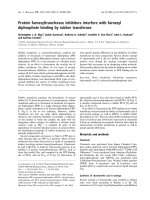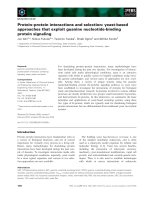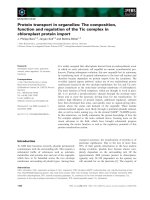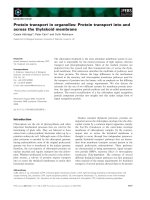Báo cáo khoa học: Protein tyrosine phosphatases: sequences and beyond ppt
Bạn đang xem bản rút gọn của tài liệu. Xem và tải ngay bản đầy đủ của tài liệu tại đây (106.08 KB, 1 trang )
MINIREVIEW SERIES
Protein tyrosine phosphatases: sequences and beyond
Wiljan J. A. J. Hendriks
1
and Andrew W. Stoker
2
1 Radboud University Nijmegen Medical Centre, the Netherlands
2 UCL Institute of Child Health, London, UK
The 21st century is bringing a flood of genomic
sequence data from diverse species and although this
information is highly accessible, we are far from
understanding its content. Recent discoveries, for
example on novel RNA types, clearly show that there
is still much to learn. In addition, the many, often
reversible, post-translational modifications imposed
upon RNAs and proteins are difficult to extract from
these primary sequence data. Powers to predict such
modification-prone sites are currently very modest, but
at least we are now able to list the modifying enzymes
involved. The future challenge is to elucidate the struc-
ture–function relationships, the imposed regulatory
mechanisms and the contributions to health and dis-
ease for these post-translational modifiers.
Phosphorylation on tyrosine residues is one key
post-translational modification that cells use to control
protein function, especially in cellular signalling path-
ways. The extent of tyrosine phosphorylation is dic-
tated by the balance of activities of protein tyrosine
kinases and protein tyrosine phosphatases (PTPs).
Since purification of the first PTP in 1988, a wide vari-
ety of PTPs has been discovered by exploiting their
well-conserved PTP signature motif (HCX5R; encom-
passing the catalytic site cysteine). The human PTP
family contains 107 members, of which 38 belong to
the phosphotyrosine-specific (‘classical’) PTP subfamily
and 61 to the so-called ‘dual-specific phosphatases’
(DUSPs). The latter can also dephosphorylate serine
and threonine residues and even phospholipids. The
exceptionally high enzyme activity and notorious sub-
strate promiscuity displayed by PTPs in vitro, have
often confounded research concerning their signalling
roles. Recent use of animal models and state-of-the-art
molecular techniques, however, has enabled the eluci-
dation of important and diverse roles for PTPs in cellu-
lar signalling pathways and development. Furthermore,
increasing knowledge about the 3D structures of PTPs
and the regulatory principles governing PTP activity,
further adds to this. Recent examples of aberrant PTP
actions underlying human diseases further corroborate
the importance of these enzymes and put them in the
limelight as novel therapeutic drug targets.
In this issue of FEBS Journal such recent advance-
ments are brought to you in a series of four reviews.
Together with Ari Elson and Sheila Harroch we pro-
vide an overview of the known functions of mamma-
lian classical PTPs as it has been extracted by studying
transgenic animal models and human disease states. Je-
roen den Hertog, Arne O
¨
stman and Frank Bo
¨
hmer
discuss the variety of regulation mechanisms exploited
by the cell to make PTP activity both controllable and
specific. In the third review, Rafael Pulido and Rob
Hooft van Huijsduijnen highlight the role of ‘non-
canonical’ DUSPs in various disease states. Finally,
Lydia Tabernero, Radu Aricescu, Yvonne Jones and
Stefan Szedlacsek focus on the PTP structure–function
relationships that now emerge from the growing list
of structural and enzymatic studies. Bearing in mind
that further, advanced technologies are now being
developed to study the impact of PTP action, even
more exciting times lay ahead.
Wiljan Hendriks (sixth from left in the photograph above, taken at the October 2007 PTPNET meeting in Jena, Germany) received his PhD in
biochemistry from the Radboud University of Nijmegen, the Netherlands, for his work on molecular evolution of eye lens proteins. As an
EMBO post-doctoral fellow he moved to the University of Zu
¨
rich, Switzerland, in 1989 and received training in the generation of knockout
mouse models. In 1991, he began his studies at the Cell Biology Department of Radboud University Nijmegen Medical Centre, on mouse
protein tyrosine phosphatase signalling.
Andrew Stoker (fifth from left in the photograph above) received his PhD in virology and biochemistry from London University in 1986 and
pursued post-doctoral training at UC Berkeley, California until 1991. From 1991 to 1998, he was a Royal Society University Research Fellow
at Oxford University. He is now a Reader at the UCL Institute of Child Health, London. His research is focused on the developmental function
of receptor type protein tyrosine phosphatases in the spinal cord and eye of avian and mammalian species. Dr Stoker is coordinating the
EU-sponsored Training Network PTPNET, in which all contributing authors of this minireview series participate (accompanying photograph).
doi: 10.1111/j.1742-4658.2008.06248.x
FEBS Journal 275 (2008) 815 ª 2008 The Authors Journal compilation ª 2008 FEBS 815









